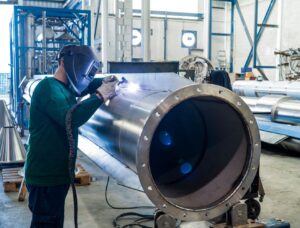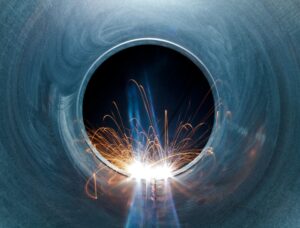When it comes to welding, choosing the right method is essential for achieving strong, high-quality welds. MIG (Metal Inert Gas) welding and TIG (Tungsten Inert Gas) welding are two of the most common processes. The choice between them depends on factors. To make the best decision, it’s crucial to understand how MIG and TIG welding work, their strengths, and their ideal applications. Incorporating advanced weld mohttps://mecaweldusa.com/nitoring systems, such as a welding camera, can also enhance precision and weld inspection for optimal results.
What Is MIG Welding?
Overview
MIG welding, also known as Gas Metal Arc Welding (GMAW), uses a continuously fed wire electrode and a shielding gas to create a weld. It’s known for its speed, efficiency, and ease of use, making it ideal for high-production welding applications.
Advantages of MIG Welding:
- Faster Welding Speed: Suitable for large-scale projects and high-volume manufacturing.
- Easier to Learn: Beginner-friendly due to its automatic wire feeding system.
- Strong Welds on Thick Materials: Works well with steel, aluminum, and stainless steel.
- Minimal Cleanup: Produces less spatter compared to stick welding.
- Automotive industry (repairing frames and body panels)
- Manufacturing and fabrication
- Structural welding (bridges, buildings, and heavy machinery)
Using a welding camera for MIG welding ensures proper shielding gas coverage and prevents common weld defects like porosity and slag inclusion.
What Is TIG Welding?
Overview
TIG welding, also called Gas Tungsten Arc Welding (GTAW), uses a tungsten electrode to generate heat while a separate filler material is added manually. This method provides high precision and clean welds, making it ideal for thin materials and detailed work.
Advantages of TIG Welding:
- Superior Weld Quality: Produces strong, precise, and visually appealing welds.
- No Spatter or Slag: Requires less post-weld cleaning.
- Excellent for Thin Materials: Works well with aluminum, stainless steel, and titanium.
- Greater Control: Welders can fine-tune heat input for delicate work.
Common Applications:
- Aerospace and aviation industry (aircraft frames and components)
- Automotive fabrication (exhaust systems and custom parts)
- Pipe welding (especially in food, medical, and pharmaceutical industries)
Since TIG welding requires high precision, a weld monitoring system can help welders closely observe the weld pool and maintain welding quality throughout the process.
MIG vs. TIG Welding: Key Differences
| Feature | MIG Welding | TIG Welding |
| Speed | Faster, better for production | Slower, requires more precision |
| Ease of Use | Easier to learn, automated wire feeding | Requires more skill and control |
| Weld Quality | Strong but may need post-cleaning | High-quality, precise welds |
| Material Suitability | Thick materials (steel, aluminum) | Thin materials (stainless steel, titanium) |
| Common Defects | Porosity, slag inclusion | Heat distortion, contamination |
| Applications | Manufacturing, automotive, construction | Aerospace, custom fabrication, piping |
Which One Should You Choose?
Choose MIG Welding If:
- You need fast, efficient welding for high-volume production.
- You’re working with thicker materials like structural steel.
- You’re a beginner looking for an easy-to-learn process.
Choose TIG Welding If:
- You require precision and high weld quality for delicate work.
- You’re welding thin or exotic metals like titanium or stainless steel.
- You need clean, aesthetically appealing welds without spatter.
Enhancing Welding Quality with a Welding Camera
Regardless of whether you choose MIG or TIG welding, maintaining welding quality is crucial. Weld monitoring cameras help welders observe the weld pool, detect issues in real time, and ensure high-quality results.
Using a weld monitoring system allows for:
- Real-time quality control to prevent weld defects.
- Accurate weld inspection to ensure proper fusion.
- Better efficiency in industrial applications like robotic welding.
For businesses looking to improve productivity and reduce errors, integrating a welding camera can be a game-changer.
Conclusion
Both MIG and TIG welding have unique benefits, and choosing the right one depends on your material, project complexity, and required precision. While MIG welding offers speed and efficiency, TIG welding provides unmatched weld quality and control.
By incorporating weld inspection techniques and using advanced welding technology, such as weld monitoring cameras, welders can optimize their processes and produce stronger, more reliable welds.
Looking for high-precision welding solutions? Explore Mecaweld’s welding cameras to enhance your welding accuracy and quality.
Contact us today to learn how real-time weld monitoring can optimize shipbuilding and repair operations!



